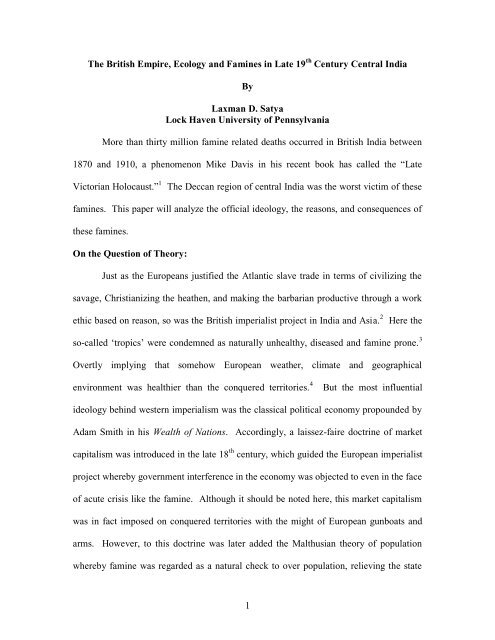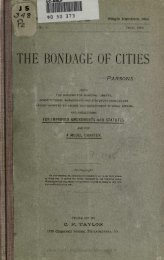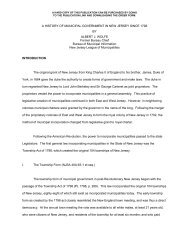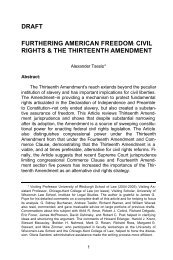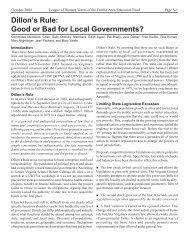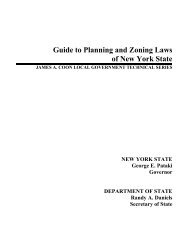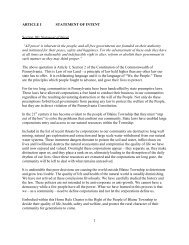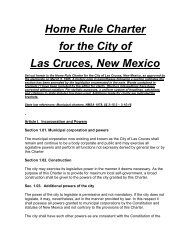The British Empire and Famine in Late 19th Century Central India
The British Empire and Famine in Late 19th Century Central India
The British Empire and Famine in Late 19th Century Central India
You also want an ePaper? Increase the reach of your titles
YUMPU automatically turns print PDFs into web optimized ePapers that Google loves.
<strong>The</strong> <strong>British</strong> <strong>Empire</strong>, Ecology <strong>and</strong> <strong>Fam<strong>in</strong>e</strong>s <strong>in</strong> <strong>Late</strong> 19 th <strong>Century</strong> <strong>Central</strong> <strong>India</strong><br />
By<br />
Laxman D. Satya<br />
Lock Haven University of Pennsylvania<br />
More than thirty million fam<strong>in</strong>e related deaths occurred <strong>in</strong> <strong>British</strong> <strong>India</strong> between<br />
1870 <strong>and</strong> 1910, a phenomenon Mike Davis <strong>in</strong> his recent book has called the “<strong>Late</strong><br />
Victorian Holocaust.” 1<br />
<strong>The</strong> Deccan region of central <strong>India</strong> was the worst victim of these<br />
fam<strong>in</strong>es. This paper will analyze the official ideology, the reasons, <strong>and</strong> consequences of<br />
these fam<strong>in</strong>es.<br />
On the Question of <strong>The</strong>ory:<br />
Just as the Europeans justified the Atlantic slave trade <strong>in</strong> terms of civiliz<strong>in</strong>g the<br />
savage, Christianiz<strong>in</strong>g the heathen, <strong>and</strong> mak<strong>in</strong>g the barbarian productive through a work<br />
ethic based on reason, so was the <strong>British</strong> imperialist project <strong>in</strong> <strong>India</strong> <strong>and</strong> Asia. 2<br />
Here the<br />
so-called „tropics‟ were condemned as naturally unhealthy, diseased <strong>and</strong> fam<strong>in</strong>e prone. 3<br />
Overtly imply<strong>in</strong>g that somehow European weather, climate <strong>and</strong> geographical<br />
environment was healthier than the conquered territories. 4<br />
But the most <strong>in</strong>fluential<br />
ideology beh<strong>in</strong>d western imperialism was the classical political economy propounded by<br />
Adam Smith <strong>in</strong> his Wealth of Nations. Accord<strong>in</strong>gly, a laissez-faire doctr<strong>in</strong>e of market<br />
capitalism was <strong>in</strong>troduced <strong>in</strong> the late 18 th century, which guided the European imperialist<br />
project whereby government <strong>in</strong>terference <strong>in</strong> the economy was objected to even <strong>in</strong> the face<br />
of acute crisis like the fam<strong>in</strong>e. Although it should be noted here, this market capitalism<br />
was <strong>in</strong> fact imposed on conquered territories with the might of European gunboats <strong>and</strong><br />
arms. However, to this doctr<strong>in</strong>e was later added the Malthusian theory of population<br />
whereby fam<strong>in</strong>e was regarded as a natural check to over population, reliev<strong>in</strong>g the state<br />
1
<strong>and</strong> government from the responsibility of expenditure on relief. 5<br />
However, the driv<strong>in</strong>g<br />
ideas beh<strong>in</strong>d the <strong>India</strong>n <strong>Fam<strong>in</strong>e</strong> Commission Reports of the 19 th century were those of<br />
Jeremy Bentham. <strong>The</strong> utilitarian pr<strong>in</strong>ciple that relief should be bitterly punitive <strong>in</strong> order<br />
to discourage dependence upon the government was purely Benthamite. <strong>The</strong> reports<br />
relieved the <strong>British</strong> government of <strong>India</strong> any responsibility for the horrific mortality. It<br />
was asserted that the cheap fam<strong>in</strong>e labour could be fruitfully used <strong>in</strong> moderniz<strong>in</strong>g<br />
projects such as the railways, road construction, <strong>and</strong> repair of tanks, stone <strong>and</strong> masonry<br />
works, etc. <strong>The</strong> fam<strong>in</strong>e reports further held that the calamity was caused by natural<br />
phenomenon <strong>and</strong> that human agencies have no control over it. <strong>The</strong> staunch Benthamite<br />
cronies like James Mill <strong>and</strong> his son John Stuart Mill also supported this utilitarian<br />
orthodoxy 6 of the East <strong>India</strong> Company <strong>and</strong> the <strong>British</strong> <strong>Empire</strong> after 1857.<br />
All the <strong>British</strong> imperial viceroys, governors, <strong>and</strong> proconsuls like Lytton, Temple,<br />
Elg<strong>in</strong>, <strong>and</strong> Curzon strongly adhered to the doctr<strong>in</strong>e that it was the climate <strong>and</strong> failure of<br />
ra<strong>in</strong>s that caused failure of crops <strong>and</strong> fam<strong>in</strong>e. It was believed that the empire had to be<br />
governed for revenues <strong>and</strong> not expenditure. And any act that would <strong>in</strong>fluence the prices<br />
of gra<strong>in</strong>s such as charity was to be either strictly monitored or discouraged. Even <strong>in</strong> the<br />
face of acute distress, relief had to be punitive <strong>and</strong> conditional. So the „Temple Wage‟<br />
propounded by Sir Richard Temple, a staunch laissez faire doctr<strong>in</strong>aire on government<br />
fam<strong>in</strong>e relief was set at only 16-22 oz of food or 1-2 annas with a m<strong>in</strong>imum of 9-10 hours<br />
of work per day. <strong>The</strong> whole idea was to strongly discourage dependence on government<br />
relief. Viceroy Lytton (<strong>in</strong> late 1870s) vehemently supported the Temple wage of below<br />
m<strong>in</strong>imum while Curzon (<strong>in</strong> early 1900s) implemented a tight press censorship to prevent<br />
<strong>India</strong>n nationalists from mak<strong>in</strong>g a political capital out of the macabre fam<strong>in</strong>e of 1899-<br />
2
1900. 7 Amartya Sen <strong>and</strong> Jean Dreze <strong>in</strong> their study have suggested that the reasons why<br />
fam<strong>in</strong>es suddenly seized with the end of <strong>British</strong> <strong>Empire</strong> (post-1947) was not so much<br />
because the nationalist government was more benevolent but because the free press <strong>and</strong><br />
public op<strong>in</strong>ion put constant pressure on the government to respond. This k<strong>in</strong>d of pressure<br />
could not be exerted under conditions of colonial subjection. 8<br />
An Exam<strong>in</strong>ation <strong>in</strong>to the Nature <strong>and</strong> Causes of <strong>Fam<strong>in</strong>e</strong>s:<br />
<strong>The</strong> scholars of ancient <strong>and</strong> medieval <strong>India</strong> like H.D. Sankhalia, D.D. Kosambi,<br />
Romila Thapar, D. N. Jha, R.S. Sharma, Irfan Habib <strong>and</strong> others have observed that the<br />
South Asian society had always been shaped <strong>and</strong> reshaped by a close <strong>in</strong>teraction between<br />
pastoral nomads, agriculturists, <strong>and</strong> forest dwellers. 9<br />
Sumit Guha <strong>in</strong> his recent book has<br />
further elaborated this observation by stat<strong>in</strong>g that the boundary between the three<br />
environmental regions, i.e., forests, graz<strong>in</strong>g grounds, <strong>and</strong> cultivated fields had always<br />
been fluid before the advent of <strong>British</strong> rule.<br />
And this fluidity also extended to<br />
occupational flexibility whereby people acquired skills <strong>in</strong> accordance with the political<br />
economy <strong>and</strong> social culture of the times. 10<br />
However, this fluidity <strong>and</strong> flexibility<br />
threatened the colonial state‟s greed for revenues <strong>and</strong> desire for territorial expansion. <strong>The</strong><br />
fluid boundaries had to be frozen <strong>and</strong> occupational flexibility had to be put <strong>in</strong>to the<br />
straightjacket category of caste for better control <strong>and</strong> management of the empire <strong>and</strong> its<br />
subjects. 11<br />
So the first order of bus<strong>in</strong>ess for the colonial state was to conduct extensive l<strong>and</strong><br />
survey <strong>and</strong> settlement operations while the process of empire build<strong>in</strong>g was <strong>in</strong> progress<br />
dur<strong>in</strong>g the n<strong>in</strong>eteenth century. 12<br />
<strong>The</strong> follow<strong>in</strong>g table shows the movement of cultivated<br />
3
<strong>and</strong> wastel<strong>and</strong> acreages as a result of <strong>British</strong> survey <strong>and</strong> settlement operations <strong>in</strong> six<br />
selected districts of <strong>Central</strong> <strong>India</strong> collectively called Berar.<br />
Table 1<br />
<strong>The</strong> movement of cultivated <strong>and</strong> uncultivated acreages <strong>in</strong> Berar by District:<br />
1869-70 to 1902-03<br />
1869-1870<br />
District Cultivated % of Cultivated Unoccupied/ % of unoccupied Total<br />
acres to total acres waste acres to total acres acres<br />
Ellichpur 630,954 35.1 414,808 23 1,795,877<br />
Amraoti 637,831 38.3 863,034 35.2 2,446,198<br />
Wun 519,554 19.1 792,324 29.2 2,708,480<br />
Akola 1,380,882 80.0 193,001 11.1 1,726,073<br />
Buldana 1,253,173 71.4 308,427 17.5 1,753,158<br />
Basim 576,715 49.8 340,937 29.4 1,155,909<br />
Total 5,299,109 45.7 2,912,531 25.1 11,585,695<br />
1901-1902<br />
Ellichpur 660,134 39.4 33,154 1.9 1,674,785<br />
Amraoti 1,505,474 85.2 120 0.006 1,765,896<br />
Wun 1,669,842 66.5 133,897 5.3 2,509,626<br />
Akola 1,454,121 84.8 6,937 0.4 1,714,459<br />
Buldana 1,468,973 81.7 6,775 0.3 1,797,901<br />
Basim 1,301,321 68.7 21,914 1.1 1,893,594<br />
Total 8,059,865 70.9 202,797 1.7 11,356,261<br />
1902-1903<br />
Total 8,101,739 71.3 181,646 1.6 11,356,181<br />
Sources: Adm<strong>in</strong>istration Report by the Resident at Hyderabad <strong>in</strong>clud<strong>in</strong>g a Report on the Adm<strong>in</strong>istration of<br />
the Hyderabad Assigned Districts, for the year 1869-70. Hyderabad: Residency Government Press. Para<br />
281; Report on the Adm<strong>in</strong>istration of the Hyderabad Assigned Districts for the year 1901-02. Hyderabad:<br />
Residency Government Press, 1902. para 9; <strong>and</strong> Report on the Adm<strong>in</strong>istration of the Hyderabad Assigned<br />
Districts for the year 1902-1903. Hyderabad: Residency Press, 1903. para 65.<br />
It can be noticed from the above table that as the l<strong>and</strong> survey <strong>and</strong> settlement operations<br />
progressed, cultivated acreage dramatically <strong>in</strong>creased from 45.7% to 71.3% of the total<br />
acreage. <strong>The</strong> result of this was a simultaneous decl<strong>in</strong>e <strong>in</strong> the unoccupied areas to the<br />
4
po<strong>in</strong>t of total ext<strong>in</strong>ction.<br />
This meant that the graz<strong>in</strong>g l<strong>and</strong>s <strong>and</strong> common grounds<br />
virtually disappeared under the onslaught of colonial commercialization. <strong>The</strong> official<br />
term for designat<strong>in</strong>g such areas was „wastel<strong>and</strong>s.‟ For the <strong>British</strong> this meant l<strong>and</strong>s that<br />
did not generate revenues, hence uneconomic <strong>and</strong> therefore the need to make it<br />
productive <strong>and</strong> economic by putt<strong>in</strong>g it under the plough. But for people <strong>in</strong> the villages,<br />
these l<strong>and</strong>s were a part of their daily life <strong>and</strong> survival <strong>in</strong> times of calamities such as<br />
fam<strong>in</strong>e <strong>and</strong> drought. Its disappearance had serious repercussions. In the most populated<br />
pla<strong>in</strong> districts of Amraoti, Akola, <strong>and</strong> Buldana, the wastel<strong>and</strong>s completely disappeared<br />
fall<strong>in</strong>g under 1%. In other districts also, it fell below 2%. In Wun district it stood at<br />
about 5%. Every district experienced the problem of space <strong>and</strong> overcrowd<strong>in</strong>g. Amraoti<br />
<strong>and</strong> Akola district suffered the worst because of the topography. When cotton cultivation<br />
exp<strong>and</strong>ed <strong>in</strong> the 1860s, these two districts were the very first to be denuded of all tree <strong>and</strong><br />
forest cover. Most of the railways passed through these two districts. <strong>The</strong> population<br />
density got high <strong>and</strong> the ravage of drought, fam<strong>in</strong>e, disease, <strong>and</strong> death became <strong>in</strong>tense. 13<br />
<strong>The</strong> <strong>Empire</strong>‟s voracious appetite for revenues targeted the mobile people to<br />
sedentarize. <strong>The</strong> pressure of colonial <strong>in</strong>stitutions like the police, law <strong>and</strong> courts were<br />
employed to coerce pastoral nomads <strong>and</strong> forest dwellers to settle on the l<strong>and</strong> <strong>and</strong> take up<br />
agriculture. Further pressure of imperial revenues forced pastures <strong>and</strong> common l<strong>and</strong>s<br />
under the plough. Neeladri Bhattacharya <strong>in</strong> his study of the Punjab pastoralists shows<br />
how the extension of <strong>British</strong> control through punitive graz<strong>in</strong>g taxes hit the transhumance<br />
pastoral nomads while depriv<strong>in</strong>g the peasantry of the traditional graz<strong>in</strong>g runs <strong>and</strong><br />
common l<strong>and</strong>s. 14<br />
Thus the extension of the imperial arm deprived pastoralists of their<br />
ma<strong>in</strong> source of survival while survey operations extended <strong>and</strong> froze the boundaries of<br />
5
agriculture. Revenue <strong>and</strong> Agriculture Department was the largest <strong>and</strong> the most organized<br />
executive arm of the <strong>British</strong> <strong>Empire</strong> <strong>in</strong> <strong>India</strong>. In fact it extracted more then 85% of the<br />
imperial revenues <strong>and</strong> made sure that agriculture closed boundary with forests. It also<br />
encouraged cash crop cultivation <strong>and</strong> helped connect <strong>India</strong> to the London based world<br />
economy. 15<br />
While commercialization of l<strong>and</strong> <strong>and</strong> agriculture threatened the existence of<br />
pastoral nomads, control over forests put pressure on forest dwellers. Writ<strong>in</strong>g <strong>in</strong> the<br />
context of <strong>Central</strong> <strong>India</strong>, Mahesh Rangarajan has aptly described the colonial<br />
commercialization of timber <strong>and</strong> other resources as „fenc<strong>in</strong>g the forest.‟ 16<br />
From time<br />
immemorial everyone <strong>in</strong> the subcont<strong>in</strong>ent had depended on forest <strong>and</strong> common l<strong>and</strong><br />
resources for their daily survival. Accord<strong>in</strong>g to Neil Charlesworth, the ratio of plough<br />
cattle to l<strong>and</strong> <strong>in</strong> the Deccan plateau heavily depended on the availability of these<br />
resources. 17<br />
As mentioned before, the people also fell back on these resources <strong>in</strong> times of<br />
drought, fam<strong>in</strong>e <strong>and</strong> other natural calamities. Ramach<strong>and</strong>ra Guha <strong>in</strong> a recent article has<br />
suggested that historically, forests <strong>in</strong> South Asia had been under the management of local<br />
society <strong>and</strong> utilized as a common property resource. 18<br />
<strong>The</strong> forest dwellers <strong>and</strong> pla<strong>in</strong>s<br />
agriculturists had always exchanged goods <strong>and</strong> services on balance. 19<br />
<strong>The</strong> colonial<br />
Forest Department took control of forests <strong>and</strong> began putt<strong>in</strong>g restrictions on people‟s<br />
access to its resources through a series of Forest Acts <strong>and</strong> Laws beg<strong>in</strong>n<strong>in</strong>g 1866. 20<br />
<strong>The</strong><br />
forest dwellers were gradually pushed out of their natural habitat <strong>and</strong> dhya (slash <strong>and</strong><br />
burn agriculture) was prohibited. <strong>The</strong> forests were taken over <strong>and</strong> declared government<br />
reserves <strong>in</strong> order to serve the needs of imperial railways <strong>and</strong> the military. 21<br />
<strong>The</strong><br />
commercialization of forest resources such as wood, leaf, manure, grass, fodder, wild<br />
6
gra<strong>in</strong>s, fruits, roots, nuts, honey, vegetables, flowers, medic<strong>in</strong>al herbs, gums, plants,<br />
spices, lac, game, etc., removed the fam<strong>in</strong>e <strong>and</strong> drought cushion on which the people had<br />
traditionally relied <strong>in</strong> times of crisis. Accord<strong>in</strong>g to the well known fam<strong>in</strong>e scholar B.M.<br />
Bhatia, this resulted <strong>in</strong> general environmental deterioration that transformed m<strong>in</strong>or<br />
calamities <strong>in</strong>to disastrous events tak<strong>in</strong>g millions of lives. 22<br />
Bipan Ch<strong>and</strong>ra, Sumit Sarkar, <strong>and</strong> Amiya Bagchi <strong>in</strong> their studies have shown that<br />
the lack of economic diversity was the reason for <strong>India</strong>‟s backwardness <strong>and</strong> poverty<br />
under the <strong>British</strong> <strong>Empire</strong>. Society was restra<strong>in</strong>ed to rema<strong>in</strong> agrarian <strong>and</strong> feudal. <strong>The</strong><br />
<strong>British</strong> imperial policies prevented the transformation of <strong>India</strong>n economy from agrarian<br />
to <strong>in</strong>dustrial by skimm<strong>in</strong>g off the raw material <strong>and</strong> revenues without plow<strong>in</strong>g anyth<strong>in</strong>g<br />
back <strong>in</strong> return. Trapped <strong>in</strong> this classical political economy of the <strong>British</strong> Raj, <strong>India</strong><br />
exported raw material <strong>and</strong> consumed f<strong>in</strong>ished goods. State <strong>in</strong>vestments mostly went <strong>in</strong>to<br />
ma<strong>in</strong>ta<strong>in</strong><strong>in</strong>g the <strong>in</strong>stitutions of control like the vast army, police, bureaucracy, <strong>and</strong> the<br />
espionage network of the <strong>Empire</strong>. Very little was made available for the development of<br />
human capital resource or even the economic <strong>in</strong>frastructure that would benefit the general<br />
populace. <strong>The</strong> colonial state <strong>and</strong> local moneylenders became parasitic classes that were<br />
not <strong>in</strong>terested <strong>in</strong> either economic development or improv<strong>in</strong>g the material condition of the<br />
peasantry. Commercial crops not only encroached on food gra<strong>in</strong>s but pushed peasants<br />
<strong>in</strong>to a debt cycle from which it was impossible to get out because the primary producer<br />
lost control over the crops. <strong>The</strong> burden of high state revenue dem<strong>and</strong> <strong>and</strong> government<br />
refusal to remit even <strong>in</strong> times of fam<strong>in</strong>e made the suffer<strong>in</strong>g of the people <strong>in</strong>tense <strong>and</strong><br />
death difficult to allude. 23<br />
7
Dur<strong>in</strong>g the great fam<strong>in</strong>e of 1877-78, a noted Victorian journalist William Digby<br />
observed that the root causes of fam<strong>in</strong>es <strong>in</strong> <strong>India</strong> was railways <strong>and</strong> markets. Accord<strong>in</strong>gly,<br />
the railways carried fam<strong>in</strong>e to gra<strong>in</strong> surplus areas through artificial price <strong>in</strong>flation <strong>in</strong> the<br />
face of any government check or control. 24<br />
Many studies s<strong>in</strong>ce then have shown that<br />
there was never a shortage of food gra<strong>in</strong>s even <strong>in</strong> years of official fam<strong>in</strong>es. <strong>The</strong> problem<br />
was with gra<strong>in</strong> prices. <strong>The</strong>y were so high that the people could not afford to buy it. 25<br />
However, one th<strong>in</strong>g rema<strong>in</strong>ed unchanged <strong>in</strong> <strong>British</strong> <strong>India</strong> <strong>and</strong> that was the wages of<br />
labourers. 26<br />
<strong>The</strong> wage stagnation <strong>and</strong> very little movement <strong>in</strong> per capita <strong>in</strong>come made<br />
food gra<strong>in</strong>s beyond the reach of ord<strong>in</strong>ary persons try<strong>in</strong>g to eke out a liv<strong>in</strong>g off their<br />
labour. <strong>The</strong> follow<strong>in</strong>g table expla<strong>in</strong>s this phenomenon for the region of Berar <strong>in</strong> <strong>Central</strong><br />
<strong>India</strong>.<br />
Table 2<br />
A comparison of wages <strong>and</strong> prices <strong>in</strong> Berar (with decennial averages): 1870-1903<br />
Year St<strong>and</strong>ard wage Price of Jawari Wage/price exchange rate<br />
*annas per diem *seers per rupee of jawari <strong>in</strong> seers<br />
1870-71 4.33 18.5 5.01<br />
1871-72 4.75 22.7 6.70<br />
1872-73 3.75 26.3 6.14<br />
1873-74 3.66 41.6 9.29<br />
1874-75 3.5 52.6 11.32<br />
1875-76 3.25 38.4 7.80<br />
1876-77 3.33 19.2 3.96<br />
1877-78 3.0 16.3 3.04<br />
1878-79 3.5 13.8 3.03<br />
1879-80 3.5 17.8 3.85<br />
1880-81 3.0 38.4 6.98<br />
Average 3.5 27.7 6.1<br />
1881-82 3.0 32.2 5.99<br />
1882-83 3.0 28.5 5.24<br />
1883-84 3.5 25.6 5.59<br />
1884-85 3.0 28.5 5.25<br />
1885-86 3.0 25.0 4.60<br />
8
1886-87 3.0 25.0 4.60<br />
1887-88 3.0 17.2 3.22<br />
1888-89 3.0 20.0 3.72<br />
1889-90 3.5 22.7 4.96<br />
1890-91 3.75 25.6 5.92<br />
Average 3.1 25.0 4.9<br />
1891-92 3.91 20.0 4.84<br />
1892-93 3.91 16.6 4.02<br />
1893-94 3.91 18.8 4.61<br />
1894-95 3.91 22.2 5.34<br />
1895-96 3.91 19.6 4.79<br />
1896-97 3.16 10.4 2.04<br />
1897-98 3.33 25.0 5.08<br />
1898-99 3.33 23.8 4.92<br />
1899-1900 2.58 9.8 1.58<br />
Average 3.5 18.4 4.1<br />
1900-01 N/A 17.9 N/A<br />
1901-02 N/A 19.5 N/A<br />
1902-03 N/A 22.4 N/A<br />
*One seer = approximately 2 lbs <strong>and</strong> anna was the 16 th part of a rupee, the st<strong>and</strong>ard currency of<br />
<strong>British</strong> <strong>India</strong><br />
Sources: Prices <strong>and</strong> Wages <strong>in</strong> <strong>India</strong>. 22 nd Issue. Compiled by the Office of the Director-General of<br />
Commercial Intelligence. Calcutta, 1905; K. L. Datta. Report on the Enquiry <strong>in</strong> the Rise of Prices <strong>in</strong> <strong>India</strong>,<br />
vol. II (Statistics of Prices), Calcutta: 1915; Statistical Bastracts Relat<strong>in</strong>g to <strong>British</strong> <strong>India</strong>, 1874-1917 (<strong>in</strong><br />
multi-volumes), London: pr<strong>in</strong>ted annually; Index Numbers of <strong>India</strong>n Prices, 1861-1926, Calcutta: 1928;<br />
Report on the Census of Berar, 1881. Bombay: 1882; Report of the Sanitary Commissioner, Hyderabad<br />
Assigned Districts for the year 1897, Hyderabad: 1898; Manchester Guardian, 1850-1900; General<br />
Adm<strong>in</strong>istration of the Hyderabad Assigned Districts, pr<strong>in</strong>ted annually from 1855-56 to 1902-03,<br />
Hyderabad: Residency Press; Report on the Revenue Adm<strong>in</strong>istration of the Hyderabad Assigned Districts,<br />
pr<strong>in</strong>ted annually 1877-78 to 1902-03; Hyderabad: Residency Press.<br />
Table 2 suggests that the st<strong>and</strong>ard cash wage rate rema<strong>in</strong>ed stagnant at 3.5 annas per diem<br />
while the price of staple gra<strong>in</strong> jawari <strong>in</strong>creased tremendously from 27.7 seers per rupee to<br />
18.4 between 1870 <strong>and</strong> 1903. This further suggests that the labourer‟s wages failed to<br />
keep up with the prices. <strong>The</strong> direct consequence of this was undernourishment <strong>and</strong> even<br />
starvation <strong>in</strong> times of fam<strong>in</strong>e. <strong>The</strong> wage/price exchange rate of jawari also fell by a third,<br />
caus<strong>in</strong>g severe economic <strong>and</strong> material hardships to the vast majority of labour<strong>in</strong>g<br />
population of central <strong>India</strong>.<br />
9
Thus, the 19 th<br />
century fam<strong>in</strong>es <strong>in</strong> <strong>Central</strong> <strong>India</strong> were basically price-<strong>in</strong>duced<br />
fam<strong>in</strong>es that could have been avoided with timely government <strong>in</strong>tervention. However,<br />
that never happened because of the official adherence to the laissez-faire ideology of<br />
non-<strong>in</strong>terference. In fact there is even evidence of gra<strong>in</strong>s be<strong>in</strong>g exported to Engl<strong>and</strong> <strong>and</strong><br />
Europe for speculative trad<strong>in</strong>g <strong>in</strong> <strong>in</strong>ternational market while millions were dy<strong>in</strong>g of<br />
disease <strong>and</strong> starvation <strong>in</strong> the sub-cont<strong>in</strong>ent. 27<br />
Similarly, the problem of food shortages <strong>in</strong><br />
colonial Berar is associated with gra<strong>in</strong> exports <strong>and</strong> high prices. It is rather appall<strong>in</strong>g that<br />
while majority of the Berar‟s population was suffer<strong>in</strong>g from poverty <strong>and</strong> hunger, the<br />
region was export<strong>in</strong>g food gra<strong>in</strong>s. This was <strong>in</strong> fact the case even dur<strong>in</strong>g years of drought<br />
<strong>and</strong> fam<strong>in</strong>e. <strong>The</strong> follow<strong>in</strong>g table illustrates exactly how much of food gra<strong>in</strong>s were<br />
actually exported. <strong>The</strong>se food gra<strong>in</strong>s <strong>in</strong>cluded the staple crop jowari (millet), wheat, <strong>and</strong><br />
other edible gra<strong>in</strong>s such as gram, bajri, masur, tur, rice, urad, etc.<br />
Table 3<br />
Food gra<strong>in</strong>s <strong>and</strong> raw cotton exports from Berar: 1874-75 to 1902-03<br />
Year Foodgra<strong>in</strong> % of foodgra<strong>in</strong>s Raw cotton % of raw cotton Total<br />
exports to total exports exports to total exports exports<br />
<strong>in</strong> maunds* <strong>in</strong> maunds <strong>in</strong> maunds<br />
1874-75 345,000 1,431,781 N/A<br />
1875-76 469,000 1,054,438 N/A<br />
1876-77 2,196,000 1,626,686 N/A<br />
1877-78 1,509,000 1,699,737 N/A<br />
1878-79 972,000 38.4 1,200,662 47.5 2,527,415<br />
1879-80 250,130 16.1 1,004,398 64.8 1,549,793<br />
1880-81 411,223 20.1 1,020,059 50.0 2,037,754<br />
1881-82 2,011,061 45.4 1,572,052 35.5 4,421,710<br />
1882-83 1,488,429 33.8 1,430,931 32.5 4,402,510<br />
1883-84 847,408 28.3 1,027,785 34.3 2,990,857<br />
1884-85 721,764 21.9 807,598 24.5 3,294,844<br />
1885-86 1,320,721 30.7 1,278,108 29.7 4,289,640<br />
1886-87 2,356,618 44.8 1,726,364 32.8 5,251,732<br />
1887-88 1,519,458 43.8 921,100 26.5 3,463,158<br />
10
1888-89 1,023,801 23.9 1,866,461 43.6 4,276,377<br />
1889-90 580,521 15.9 1,902,429 52.3 3,635,968<br />
1890-91 N/A N/A 3,926,000<br />
1891-92 1,943,000 36.2 1,714,338 32.0 5,355,000<br />
1892-93 1,067,000 28.8 1,355,420 36.6 3,701,000<br />
1893-94 2,020,372 53.7 1,651,022 43.9 3,760,000<br />
1894-95 235,000 8.7 1,211,933 45.0 2,691,000<br />
1895-96 475,000 12.4 1,954,056 51.3 3,809,000<br />
1896-97 655,000 18.5 1,827,708 51.8 3,522,000<br />
1897-98 257,000 8.2 1,686,115 53.9 3,128,000<br />
1898-99 500,000 8.7 3,208,228 55.8 5,747,000<br />
1899-1900 747,000 28.6 915,157 35.0 2,609,000<br />
1900-01 275,000 6.4 2,183,142 51.5 4,233,000<br />
1901-02 835,000 10.6 3,830,744 48.8 7,842,000<br />
1902-03 483,000 7.6 3,218,399 50.8 6,324,000<br />
--------- ----- ---------- -----<br />
Average 979,910 24.5 1,654,530 42.9<br />
-------- ----- ---------- -----<br />
*1 Berar maund = 82 lbs. weight<br />
Sources: Report on the Rail <strong>and</strong> Road Borne Trade of the Hyderabad Assigned Districts, 1878-79 to 1902-03. Pr<strong>in</strong>ted<br />
annually at Hyderabad: Residency Government Press; <strong>and</strong> East <strong>India</strong> (Report of <strong>Fam<strong>in</strong>e</strong>). Appendix I: Miscellaneous<br />
Papers Bear<strong>in</strong>g Upon the Condition of the Country <strong>and</strong> People of <strong>India</strong>. London: Eyre <strong>and</strong> Spottiswoode, 1881. p. 50;<br />
<strong>and</strong> <strong>Central</strong> Prov<strong>in</strong>ces <strong>and</strong> Berar District Gazetteer: Akola District. Calcutta: Baptist Mission Press, 1910. p. 245.<br />
<strong>The</strong> above table clearly <strong>in</strong>dicates that at any given po<strong>in</strong>t of time, Berar was export<strong>in</strong>g<br />
precious food gra<strong>in</strong>s worth 979,910 maunds (40,176 tons). This enormous quantity was<br />
primarily snatched from the mouths of the hungry <strong>and</strong> the poor. With the average<br />
population of 2,637,958 persons at any given po<strong>in</strong>t between 1867 <strong>and</strong> 1901, 28 this loss<br />
amounted to approximately 30.4 lbs per person. Accord<strong>in</strong>g to the general adm<strong>in</strong>istration<br />
report of 1882-83, an average <strong>in</strong>dividual required 0.96 lbs of food gra<strong>in</strong> per diem for<br />
survival. 29<br />
Even if this relatively low consumption figure is applied, the surplus food<br />
gra<strong>in</strong> that was exported could have susta<strong>in</strong>ed the entire population of Berar for up to 31.7<br />
days. Even <strong>in</strong> the worst of fam<strong>in</strong>e <strong>and</strong> drought years (1877-79; 1896-97; <strong>and</strong> 1899-1900)<br />
a total of 2,375,509 maunds of food gra<strong>in</strong>s were exported out of the prov<strong>in</strong>ce. Similarly,<br />
the people of Berar never got anyth<strong>in</strong>g <strong>in</strong> return for the raw cotton exports that formed on<br />
11
average 42.9% of the total exports <strong>in</strong> any given year. <strong>The</strong> colonial roads <strong>and</strong> railways<br />
became the artery of people‟s misery. With such large quantities of gra<strong>in</strong>s leav<strong>in</strong>g the<br />
prov<strong>in</strong>ce, the traditional custom of stor<strong>in</strong>g gra<strong>in</strong>s <strong>in</strong> „peos‟ completely decl<strong>in</strong>ed. 30<br />
Thus<br />
the high gra<strong>in</strong> prices <strong>and</strong> exports did not necessarily translate <strong>in</strong>to <strong>in</strong>creas<strong>in</strong>g <strong>in</strong>comes for<br />
peasants as Michele McAlph<strong>in</strong> <strong>and</strong> Morris D. Morris have surmised. 31<br />
Nor did it mean a<br />
change <strong>in</strong> their material condition. In fact it led to worsen<strong>in</strong>g of their lives.<br />
Vasant Kaiwar <strong>in</strong> his studies of the Deccan has suggested that the <strong>in</strong>corporation of<br />
local economy <strong>in</strong>to the world market network brought devastat<strong>in</strong>g fam<strong>in</strong>es to central<br />
<strong>India</strong>. <strong>The</strong> encroachment of imperial policies <strong>and</strong> imposition of a colonial <strong>in</strong>frastructure<br />
based on conditional private property <strong>in</strong> l<strong>and</strong> 32 <strong>and</strong> a high rate of revenue dem<strong>and</strong><br />
underm<strong>in</strong>ed the traditional food security cha<strong>in</strong>. 33<br />
Similarly, David Hardiman argues that<br />
the neglect of traditional water works by the colonial state brought drought <strong>and</strong> fam<strong>in</strong>e to<br />
the Deccan plateau. <strong>The</strong>se water works <strong>in</strong> the form of small irrigation systems like tanks,<br />
masonry dams, anicuts, reservoirs, lakes, ponds, canals, etc., had successfully avoided the<br />
problem of sal<strong>in</strong>ation <strong>and</strong> malaria by tapp<strong>in</strong>g water for local irrigation <strong>and</strong> daily use. In<br />
pre-colonial times, the ma<strong>in</strong>tenance of these water works had been through local<br />
communal labour f<strong>in</strong>anced by the state <strong>in</strong> a situation where l<strong>and</strong>, graz<strong>in</strong>g grounds <strong>and</strong><br />
surround<strong>in</strong>g forests were a common property resource of the village. <strong>The</strong> <strong>in</strong>troduction of<br />
conditional private property rights <strong>in</strong> l<strong>and</strong> under colonial aegis <strong>and</strong> withdrawal of state<br />
support led to the decl<strong>in</strong>e of local irrigation works. 34<br />
Not surpris<strong>in</strong>gly, one of the most<br />
acute problems dur<strong>in</strong>g fam<strong>in</strong>e <strong>in</strong> <strong>Central</strong> <strong>India</strong> was that of water scarcity. Elizabeth<br />
Whitcombe, Ira Kle<strong>in</strong>, <strong>and</strong> David Gilmart<strong>in</strong> have also suggested that the <strong>British</strong> neglect<br />
of small water works <strong>in</strong> favour of large irrigation canals were the chief cause of<br />
12
sal<strong>in</strong>ation, silt<strong>in</strong>g, leach<strong>in</strong>g, disease, <strong>and</strong> fam<strong>in</strong>e that were triggered by a general<br />
environmental collapse. 35<br />
P.A. Elph<strong>in</strong>stone conducted extensive survey <strong>and</strong> settlement operations <strong>in</strong> the<br />
Deccan <strong>in</strong> 1860s <strong>and</strong> 70s. In his reports he poignantly noted the neglect of traditional<br />
water works <strong>and</strong> the acute problem of water scarcity. 36<br />
But every subsequent colonial<br />
official <strong>in</strong> this cotton rich region of <strong>Central</strong> <strong>India</strong> came to believe that there was no need<br />
to develop irrigation or water works because the black cotton soil was naturally rich <strong>and</strong><br />
did not need much water to grow crops. A strong anti-irrigation lobby among the<br />
officials created this myth that Berar was immune from drought <strong>and</strong> fam<strong>in</strong>e. <strong>The</strong>refore<br />
the need for a fam<strong>in</strong>e code or relief measures were neither felt nor devised. With this<br />
attitude, the officials <strong>in</strong> fact refused to even acknowledge that drought, disease, <strong>and</strong><br />
fam<strong>in</strong>e related deaths were tak<strong>in</strong>g place. 37<br />
This denial <strong>and</strong> failure to put <strong>in</strong> place even a<br />
semblance of <strong>in</strong>frastructure made the fam<strong>in</strong>e <strong>in</strong> <strong>Central</strong> <strong>India</strong> all the more devastat<strong>in</strong>g.<br />
Similarly, the sanitary commissioner‟s reports actually drew a strong connection between<br />
contam<strong>in</strong>ated water <strong>and</strong> diseases like cholera, malaria, diarrhea, dysentery <strong>and</strong> smallpox,<br />
not to mention undernourishment caused by the low calorie <strong>in</strong>take of the general mass of<br />
population. 38<br />
Yet, no public action was forthcom<strong>in</strong>g. And when serious fam<strong>in</strong>es did hit<br />
the region (1877-78; 1896-97 <strong>and</strong> 1899-1900) <strong>and</strong> the state was forced to recognize it on<br />
account of millions of deaths, the blame was put on natural causes like the failure of ra<strong>in</strong>s<br />
<strong>and</strong> crops. 39<br />
However, a simple common sense query would demolish this colonialist<br />
argument. If the region is naturally rich with black cotton soil <strong>and</strong> does not need much<br />
water to grow crops, then how can failure of ra<strong>in</strong> cause fam<strong>in</strong>es?<br />
13
Radhika Ramasubban <strong>in</strong> her work on epidemic diseases <strong>and</strong> medic<strong>in</strong>e <strong>in</strong> colonial<br />
<strong>India</strong> has argued that government sanitation measures were primarily geared towards<br />
protect<strong>in</strong>g <strong>British</strong> cantonments <strong>and</strong> civil l<strong>in</strong>es where most of the European population<br />
was concentrated. This „enclavist‟ nature of colonial medic<strong>in</strong>e failed to protect the vast<br />
majority of the people not just dur<strong>in</strong>g fam<strong>in</strong>es but also <strong>in</strong> ord<strong>in</strong>ary times. 40<br />
And the<br />
railways took plague <strong>and</strong> cholera along with gra<strong>in</strong>s to every nook <strong>and</strong> corner of <strong>Central</strong><br />
<strong>India</strong> from the port city of Bombay. 41<br />
However, Irfan Habib states that the dark<br />
underly<strong>in</strong>g cause of all fam<strong>in</strong>es <strong>in</strong> <strong>British</strong> <strong>India</strong> was the <strong>in</strong>tense poverty of its masses.<br />
And this suggests a deep relationship between the colonial political economy of<br />
exploitation <strong>and</strong> the material condition of the masses. 42<br />
As already mentioned, the extensive l<strong>and</strong> survey operations conducted <strong>in</strong> Berar <strong>in</strong><br />
1860s <strong>and</strong> 70s were designed for revision every thirty years. <strong>The</strong> first revision took place<br />
<strong>in</strong> 1898-99, but unfortunately most of the revision settlement reports have either been lost<br />
or yet to be found. However, only one of the report survived through time <strong>and</strong> this report<br />
was done <strong>in</strong> 1900 for the Basim taluka 43 <strong>in</strong> Basim district by a one F. W. Francis, the<br />
Director of L<strong>and</strong> Records <strong>and</strong> Agriculture.<br />
In this report there is one extremely<br />
<strong>in</strong>terest<strong>in</strong>g data that shows a rather rare comparison <strong>in</strong> the people‟s st<strong>and</strong>ard of liv<strong>in</strong>g<br />
dur<strong>in</strong>g these two time periods twenty-five years apart. It is worthwhile here to reproduce<br />
the comparative data:<br />
Table 4<br />
Comparative statistics from the first settlement to the revision settlement <strong>in</strong> Basim<br />
taluka of Berar <strong>in</strong> <strong>Central</strong> <strong>India</strong> (some parameters of the st<strong>and</strong>ard of liv<strong>in</strong>g <strong>in</strong> an<br />
agrarian society): 1872-73 <strong>and</strong> 1898-99<br />
Subject 1872-73 1898-99<br />
14
No. of houses per head population 0.25 0.17<br />
No. of agricultural cattle per head<br />
of population 0.43 0.31<br />
No. of cows <strong>and</strong> buffaloes per head<br />
of population 0.60 0.42<br />
No. of sheep <strong>and</strong> goats per head of<br />
population 0.08 0.11<br />
No. of carts per head of population 0.04 0.03<br />
No. of wells per head of population 0.03 0.02<br />
No. of cultivated acres head of population 5.7 3.1<br />
Source: Bas<strong>in</strong> Taluka Settlement Report, Prepared bh F.W. Francis, Director of L<strong>and</strong> Records <strong>and</strong><br />
Agriculture, Hyderabad Assigned Districts, Chikalda (April 25, 1900), p. 4.<br />
<strong>The</strong> above table is just for the taluka of Basim. However, it certa<strong>in</strong>ly suggests a trend for<br />
the period <strong>and</strong> perhaps for the prov<strong>in</strong>ce as a whole. It should be noted that Basim is a<br />
hilly jungle taluk <strong>and</strong> if the situation was decl<strong>in</strong><strong>in</strong>g <strong>in</strong> the hill districts, then <strong>in</strong> the pla<strong>in</strong><br />
districts where cultivation is more extensive, the <strong>in</strong>tensity of decl<strong>in</strong>e would be perhaps<br />
even greater. And consider<strong>in</strong>g the severity of the fam<strong>in</strong>es <strong>in</strong> the clos<strong>in</strong>g decades of the<br />
19 th century, it may well be that the st<strong>and</strong>ard of liv<strong>in</strong>g was decl<strong>in</strong><strong>in</strong>g <strong>in</strong> the entire<br />
prov<strong>in</strong>ce. For example, the number of houses per capita decl<strong>in</strong>ed along with cattle heads,<br />
carts, wells, <strong>and</strong> cultivated acreage. This certa<strong>in</strong>ly suggests an overall decl<strong>in</strong>e <strong>in</strong> the<br />
st<strong>and</strong>ard of liv<strong>in</strong>g. Decl<strong>in</strong>e <strong>in</strong> the number of wells <strong>and</strong> cultivated acres surely led to acute<br />
water <strong>and</strong> food availability decl<strong>in</strong>e throughout the prov<strong>in</strong>ce as droughts <strong>and</strong> fam<strong>in</strong>es<br />
periodically devastated the region. Widespread drought <strong>and</strong> fam<strong>in</strong>e related disasters are<br />
reported <strong>in</strong> the colonial documents for the years: 1862; 1865-66; 1868; 1871; 1875; 1878;<br />
1883-84; 1885; 1886-87; 1887-88; 1896-97; <strong>and</strong> 1899-1900 <strong>in</strong> which diseases decimated<br />
cattle <strong>and</strong> people without dist<strong>in</strong>ction. 44<br />
So even though only three fam<strong>in</strong>es were officially<br />
recognized, there were many other years when drought <strong>and</strong> fam<strong>in</strong>e conditions existed but<br />
were never recognized by the colonial state. And most of the deaths <strong>in</strong> fact took place<br />
dur<strong>in</strong>g these officially non-drought <strong>and</strong> fam<strong>in</strong>e years.<br />
15
On the Consequences of <strong>Fam<strong>in</strong>e</strong>:<br />
<strong>The</strong> consequences of these fam<strong>in</strong>es were quite dramatic. South Asian scholars like<br />
K<strong>in</strong>sley Davis, Tim Dyson <strong>and</strong> others who study demography <strong>and</strong> productivity agree that<br />
between 1870 <strong>and</strong> 1920 the life expectancy fell by 20%, population decl<strong>in</strong>ed by 10% <strong>and</strong><br />
net cropped area decreased by 12%. 45<br />
It can also be argued that although the colonial<br />
state reluctantly recognized only three fam<strong>in</strong>es <strong>in</strong> the late 19 th century, yet drought like<br />
conditions prevailed <strong>in</strong> general throughout <strong>Central</strong> <strong>India</strong> tak<strong>in</strong>g a heavy toll of human <strong>and</strong><br />
cattle lives.<br />
Despite extract<strong>in</strong>g millions of pounds <strong>in</strong> revenues, the state developed cold feet<br />
when it came to spend<strong>in</strong>g on public relief. <strong>The</strong> government was always worried about<br />
commensurate returns on its <strong>in</strong>vestments.<br />
And expenditure on fam<strong>in</strong>e relief was<br />
considered wasteful <strong>and</strong> uneconomic. In fact it was even looked down upon <strong>in</strong> official<br />
circles. Keep<strong>in</strong>g <strong>in</strong> l<strong>in</strong>e with the imperial ideology, every effort was made to discourage<br />
people from seek<strong>in</strong>g relief. <strong>The</strong> relief camps were not only hard to reach but were <strong>in</strong> fact<br />
deliberately kept <strong>in</strong> remote locations <strong>and</strong> beyond the reach of the physically weakened<br />
population. And those who somehow managed to reach these camps soon found that the<br />
conditions were more horrify<strong>in</strong>g then the villages they had left beh<strong>in</strong>d. <strong>The</strong> sanitation<br />
was often very poor <strong>and</strong> prison like conditions prevailed while the relief camps ga<strong>in</strong>ed<br />
notoriety as centers of epidemic diseases.<br />
It will be worth repeat<strong>in</strong>g here that all<br />
government relief was conditional upon heavy work <strong>in</strong> colonial projects on which both<br />
16
cash <strong>and</strong> k<strong>in</strong>d wages were deliberately kept low. 46<br />
And <strong>in</strong> general, the state did not show<br />
much <strong>in</strong>terest <strong>in</strong> fam<strong>in</strong>e relief.<br />
But even <strong>in</strong> this weakened state, there was resistance to what Partha Chatterjee<br />
has called the „colonial [<strong>in</strong>]difference.‟ 47<br />
<strong>The</strong>re are <strong>in</strong>numerable recorded <strong>in</strong>stances of<br />
gra<strong>in</strong> riots, attacks on gra<strong>in</strong> tra<strong>in</strong>s, protest aga<strong>in</strong>st high prices <strong>and</strong> gra<strong>in</strong> exports, hoard<strong>in</strong>g<br />
<strong>and</strong> speculative trad<strong>in</strong>g, house trespass, bazaar unrest, offence aga<strong>in</strong>st property, raids on<br />
st<strong>and</strong><strong>in</strong>g debt crops held by moneylenders, raids on government establishments,<br />
robberies, thefts, <strong>in</strong>cendiaries, <strong>and</strong> dacoities. 48 Some of them like the Deccan Riots <strong>in</strong><br />
Poona <strong>in</strong> 1870s became symbols of bigger protests launched by the nationalist<br />
organizations like the Poona Sarvajanik Sabha <strong>and</strong> the <strong>India</strong>n National Congress. 49<br />
Coda for the Victims of <strong>Fam<strong>in</strong>e</strong> <strong>in</strong> Colonial <strong>India</strong>:<br />
In conclusion then, the laissez-faire ideology of the <strong>British</strong> <strong>Empire</strong> prevented state<br />
<strong>in</strong>tervention <strong>in</strong> times of calamities such as droughts <strong>and</strong> fam<strong>in</strong>es. Western technology<br />
like the railways took gra<strong>in</strong>s out <strong>and</strong> brought fam<strong>in</strong>e even to surplus areas. This paper<br />
argues that the fam<strong>in</strong>es were caused not so much by the failure of ra<strong>in</strong>s but by artificial<br />
price <strong>in</strong>flations driven by the colonial policies <strong>and</strong> export trade.<br />
In an oppressive<br />
situation of colonial subjection <strong>and</strong> imperial dom<strong>in</strong>ation over forests, graz<strong>in</strong>g l<strong>and</strong>s, <strong>and</strong><br />
agriculture, the society rema<strong>in</strong>ed socially <strong>and</strong> economically <strong>in</strong>voluted.<br />
But most<br />
significantly it got exposed to droughts <strong>and</strong> fam<strong>in</strong>es that mercilessly decimated millions<br />
<strong>in</strong> the late 19 th century. However, even <strong>in</strong> their weakened state the people resisted to<br />
their last breadth <strong>and</strong> gave birth the <strong>India</strong>n nationalism.<br />
Endnotes:<br />
17
1 Mike Davis. <strong>Late</strong> Victorian Holocausts: El N<strong>in</strong>o <strong>Fam<strong>in</strong>e</strong>s <strong>and</strong> the Mak<strong>in</strong>g of the Third<br />
World. London: Verso, 2001.<br />
2 See Jim Blaut. <strong>The</strong> Colonizer’s Model of the World: Geographical Diffusionism <strong>and</strong><br />
Euro-centric History. New York: <strong>The</strong> Guilford Press, 1993.<br />
3 See Sheldon Watts. Epidemics <strong>and</strong> History: Disease, Power <strong>and</strong> Imperialism. New<br />
Haven: Yale University Press, 1997.<br />
4 See Jared Diamond. Guns, Germs, <strong>and</strong> Steel: <strong>The</strong> Fates of Human Societies. New<br />
York: Norton, 1997; David L<strong>and</strong>es, <strong>The</strong> Wealth <strong>and</strong> Poverty of Nations: Why Some Are<br />
So Rich <strong>and</strong> Some So Poor (New York: Norton, 1998).<br />
5 See John Caldwell. “Malthus <strong>and</strong> the Less Developed World: <strong>The</strong> Pivotal Role of<br />
<strong>India</strong>.” Population <strong>and</strong> Development Review 24:4 (Dec. 1998).<br />
6 See Eric Stokes. <strong>The</strong> English Utilitarians <strong>and</strong> <strong>India</strong>. Oxford: Oxford University Press,<br />
1959.<br />
7 See B. M. Bhatia. <strong>Fam<strong>in</strong>e</strong>s <strong>in</strong> <strong>India</strong>, 1850-1945. Bombay, 1963; <strong>and</strong> Mike Davis. <strong>Late</strong><br />
Victorian Holocausts. Chs. 1 & 5.<br />
8 See Jean Dreze <strong>and</strong> Amartya Sen. <strong>The</strong> Political Economy of Hunger: Selected Essays.<br />
Oxford: Oxford University Press, 1995; <strong>and</strong> Amartya Sen. Poverty <strong>and</strong> <strong>Fam<strong>in</strong>e</strong>s: An<br />
Essay on Entitlement <strong>and</strong> Deprivation. Oxford: Oxford University Press, 1984.<br />
9 See the works of H.D. Sankhalia. <strong>The</strong> Prehistory <strong>and</strong> protohistory of <strong>India</strong> <strong>and</strong><br />
Pakistan. Poona, 1974; D.D. Kosambi. Ancient <strong>India</strong>: A History of Its Culture <strong>and</strong><br />
Civilization. New York: Pantheon Book, 1965; Romila Thapar. A History of <strong>India</strong>,<br />
Volume 1. London: Pengu<strong>in</strong> Books, 1990; D. N. Jha, Ancient <strong>India</strong> <strong>in</strong> Historical Outl<strong>in</strong>e.<br />
New Delhi: Manohar, 1998; R.S. Sharma. <strong>India</strong>n Feudalism, circa A.D. 300-1200.<br />
18
Delhi, 1980; <strong>and</strong> Irfan Habib. <strong>The</strong> Agrarian System of Mughal <strong>India</strong>, 1556-1707.<br />
Bombay, 1963.<br />
10 Sumit Guha. Environment <strong>and</strong> Ethnicity <strong>in</strong> <strong>India</strong>, 1200-1991. Cambridge: Cambridge<br />
University Press, 1999.<br />
11 Nicholas Dirks. Castes of M<strong>in</strong>d: Colonialism <strong>and</strong> the Mak<strong>in</strong>g of Modern <strong>India</strong>.<br />
Pr<strong>in</strong>ceton: Pr<strong>in</strong>ceton University Press, 2001.<br />
12 Laxman D. Satya. “Colonial Encroachment <strong>and</strong> Popular Resistance: L<strong>and</strong> Survey <strong>and</strong><br />
Settlement Operations <strong>in</strong> Berar: 1860-1877.” Agricultural History 72: 1 (W<strong>in</strong>ter 1998):<br />
55-76.<br />
13 <strong>Central</strong> Prov<strong>in</strong>ces District Gazetteers: Amraoti District (Bombay: Caxton Works,<br />
1911), pp. 106-111; <strong>and</strong> <strong>Central</strong> Prov<strong>in</strong>ces <strong>and</strong> Berar District Gazetteers: Akola District<br />
(Calcutta: Baptist Mission Press, 1910), pp. 231-251.<br />
14 Neeladri Bhattacharya. “Pastoralists <strong>in</strong> a Colonial World,” <strong>in</strong> David Arnold <strong>and</strong><br />
Ramach<strong>and</strong>ra Guha, ed., Nature, Culture, Imperialism: Essays on the Environmental<br />
History of South Asia. Delhi: Oxford University Press, 1998. Pp. 49-85.<br />
15 Irfan Habib. Essays <strong>in</strong> <strong>India</strong>n History: Towards a Marxist Perception. New Delhi:<br />
Tulika, 1995. Pp. 296-335.<br />
16 See Mahesh Rangarajan. Fenc<strong>in</strong>g the Forest: Conservation <strong>and</strong> Ecological Change <strong>in</strong><br />
<strong>India</strong>’s <strong>Central</strong> Prov<strong>in</strong>ces, 1860-1914. Delhi: Oxford University Press, 1996.<br />
17 Neil Charlesworth. Peasants <strong>and</strong> Imperial Rule: Agriculture <strong>and</strong> Agrarian Society <strong>in</strong><br />
the Bombay Presidency:1850-1935. Cambridge: Cambridge University Press, 2002.<br />
18 Ramach<strong>and</strong>ra Guha. “<strong>The</strong> Prehistory of Community Forestry <strong>in</strong> <strong>India</strong>.” Environmental<br />
History 6: 2 (Apr 2001): 213-238.<br />
19
19 Vanita Damodaran. “<strong>Fam<strong>in</strong>e</strong> <strong>in</strong> a Forest Tract: Ecological Change <strong>and</strong> he Causes of the<br />
1897 <strong>Fam<strong>in</strong>e</strong> <strong>in</strong> Chota Nagpur – North <strong>India</strong>.” In Richard Grove, et. al. eds. Nature <strong>and</strong><br />
the Orient: <strong>The</strong> Environmental History of South <strong>and</strong> Southeast Asia. Delhi: Oxford<br />
University Press, 1998; <strong>and</strong> D.E.U. Baker. Colonialism <strong>in</strong> an <strong>India</strong>n H<strong>in</strong>terl<strong>and</strong>: <strong>The</strong><br />
<strong>Central</strong> Prov<strong>in</strong>ces, 1820-1920. Delhi, 1993.<br />
20 Ram Guha. “An environmental history debate: <strong>The</strong> mak<strong>in</strong>g of the 1878 Forest Act.”<br />
<strong>The</strong> <strong>India</strong>n Economic <strong>and</strong> Social History Review 27:1 (1990): 65-84.<br />
21 Indira Munshi Saldhana. “Colonial Forest Regulation <strong>and</strong> Collective Resistance: 19 th<br />
<strong>Century</strong> Thana District.” In Richard Grove, et. al. ed. Nature <strong>and</strong> the Orient: <strong>The</strong><br />
Environmental History of South <strong>and</strong> Southeast Asia.<br />
22 B. Bhatia. <strong>Fam<strong>in</strong>e</strong>s <strong>in</strong> <strong>India</strong>, 1850-1945. Bombay, 1963; <strong>and</strong> Ramach<strong>and</strong>ra Guha <strong>and</strong><br />
Madhav Gadgil. This Fissured L<strong>and</strong>: An Ecological History of <strong>India</strong>. Delhi: Oxford<br />
University Press, 1996.<br />
23 See Bipan Ch<strong>and</strong>ra. <strong>The</strong> Rise <strong>and</strong> Growth of Economic Nationalism <strong>in</strong> <strong>India</strong>:<br />
Economic Policies of <strong>India</strong>n Nationalist Leadership, 1885-1905. New Delhi, 1966; Sumit<br />
Sarkar. Modern <strong>India</strong>, 1885-1947. Delhi: McMillan, 1983; <strong>and</strong> Amiya Bagchi. Private<br />
Investments <strong>in</strong> <strong>India</strong>, 1900-1939. Cambridge: Cambridge University Press, 1972.<br />
24 See William Digby. Prosperous <strong>British</strong> <strong>India</strong>. London, 1901.<br />
25 See Amartya Sen. “<strong>Fam<strong>in</strong>e</strong> Mortality: A Study of the Bengal <strong>Fam<strong>in</strong>e</strong> of 1943.” In E.<br />
Hobsbawm, et. al. eds. Peasants <strong>in</strong> History. Oxford: Oxford University Press, 1980.<br />
26 See Laxman D. Satya. Cotton <strong>and</strong> <strong>Fam<strong>in</strong>e</strong> <strong>in</strong> Berar: 1850-1900. Delhi: Manohar,<br />
1997. Ch. 7; <strong>and</strong> Mike Davis. <strong>Late</strong> Victorian Holocausts. P. 310.<br />
20
27 Mike Davis. <strong>Late</strong> Victorian Holocausts. P. 11; <strong>and</strong> Michael Watts. Silent Violence:<br />
Food, <strong>Fam<strong>in</strong>e</strong> <strong>and</strong> Peasantry <strong>in</strong> Northern Nigeria. Berkeley: University of California<br />
Press, 1983.<br />
28 Tim Dyson. “<strong>The</strong> Population History of Berar s<strong>in</strong>ce 1881 <strong>and</strong> its potential wider<br />
significance.” <strong>India</strong>n Economic <strong>and</strong> Social History Review 24:2 (1989): 168.<br />
29 Report on the Adm<strong>in</strong>istration of the Hyderabad Assigned Districts for the year 1882-<br />
83. Hyderabad: Residency Government Press, 1883. para 12.<br />
30 <strong>The</strong> Report of the <strong>India</strong>n <strong>Fam<strong>in</strong>e</strong> Commission, 1898. London: Her Majesty‟s<br />
Stationery Office, 1898. p. 363.<br />
31 Michele McAlph<strong>in</strong>. Subject to <strong>Fam<strong>in</strong>e</strong>: Food Crisis <strong>and</strong> Economic Change <strong>in</strong> Western<br />
<strong>India</strong>, 1860-1920. New Jersey, 1983; <strong>and</strong> for a critique of McAlph<strong>in</strong> see, Currie, Kate,<br />
“<strong>Fam<strong>in</strong>e</strong>s <strong>in</strong> 19 th<br />
<strong>Century</strong> <strong>India</strong>n History: A Materialist Alternative to Ecological<br />
Reductionism,” Journal of Contemporary Asia 16:4 (1986): 475-490.<br />
32 <strong>The</strong> colonial condition be<strong>in</strong>g, the regular payment of l<strong>and</strong> revenue under the threat of<br />
seizure <strong>and</strong> court auction for default.<br />
33 See Vasant Kaiwar “<strong>The</strong> Colonial State, Capital <strong>and</strong> the Peasantry <strong>in</strong> Bombay<br />
Presidency.” Modern Asian Studies 28:4 (1994): 793-832.<br />
34 David Hardiman. “Small-Dam Systems of the Sahyadris.” See David Arnold <strong>and</strong><br />
Ramach<strong>and</strong>ra Guha, eds., Nature, Culture, <strong>and</strong> Imperialism: Essays on the<br />
Environmental History of South Asia. Delhi: Oxford University Press, 1998.<br />
35 Whitcombe, Elizabeth, “<strong>The</strong> Environmental Costs of Irrigation <strong>in</strong> <strong>British</strong> <strong>India</strong>:<br />
Waterlogg<strong>in</strong>g, Sal<strong>in</strong>ity <strong>and</strong> Malaria,” <strong>in</strong> David Arnold <strong>and</strong> Ramach<strong>and</strong>ra Guha, eds.,<br />
Nature, Culture, <strong>and</strong> Imperialism: Essays on the Environmental History of South Asia.<br />
21
Delhi: Oxford University Press, 1998: 237-259; <strong>and</strong> Kle<strong>in</strong>, Ira. “Development <strong>and</strong> death:<br />
Re<strong>in</strong>terpret<strong>in</strong>g malaria, economics <strong>and</strong> ecology <strong>in</strong> <strong>British</strong> <strong>India</strong>.” <strong>The</strong> <strong>India</strong>n Economic<br />
<strong>and</strong> Social History Review 38:2 (2001): 147-179; <strong>and</strong> Gilmart<strong>in</strong>, David, “Scientiific<br />
<strong>Empire</strong> <strong>and</strong> Imperial Science: Colonialism <strong>and</strong> Irrigation Technology <strong>in</strong> the Indus Bas<strong>in</strong>,”<br />
Journal of Asian Studies 53:4 (November 1994): 1127-1149.<br />
36 Elph<strong>in</strong>stone wrote several settlement reports as survey officer. Here only two most<br />
important once are mentioned, Mehkur Taluka Settlement Report, no. 1098 of 1868; <strong>and</strong><br />
Morsi Taluka Settlement Report, No. 563 of 1871.<br />
37 Laxman D. Satya. Cotton <strong>and</strong> <strong>Fam<strong>in</strong>e</strong> <strong>in</strong> Berar: 1850-1900. Ch. 7.<br />
38 Sanitary Commissioner‟s Reports were published annually between 1873 <strong>and</strong> 1902<br />
under the title: Report of the Sanitary Commissioner of the Hyderabad Assigned<br />
Districts, for the year…..published by the <strong>British</strong> Resident at Hyderabad.<br />
39 <strong>Fam<strong>in</strong>e</strong> commission reports <strong>and</strong> every colonial document of the 19 th century repeated<br />
this refra<strong>in</strong>. For example, see J. A. Crawford. Report on the <strong>Fam<strong>in</strong>e</strong> <strong>in</strong> the Hyderabad<br />
Assigned Districts <strong>in</strong> the years 1899 <strong>and</strong> 1900, vol. 1. Nagpur: Chambers Press, 1901; F.<br />
S. Bullock. Narrative of the <strong>Fam<strong>in</strong>e</strong> <strong>in</strong> the Hyderabad Assigned Districts dur<strong>in</strong>g the year<br />
1896-97. Hyderabad: Residency Pr<strong>in</strong>t<strong>in</strong>g Office, 1898; <strong>and</strong> Report of the <strong>India</strong>n <strong>Fam<strong>in</strong>e</strong><br />
Commission. Vol. III. Evidence <strong>in</strong> Reply to Inquiries of the Commission. Ch. 1 –<br />
Condition of the Country <strong>and</strong> People. London: Eyre <strong>and</strong> Spottiswoode, 1880.<br />
40 See Ramasubban, Radhika. “Imperial health <strong>in</strong> <strong>British</strong> <strong>India</strong>, 1857-1900.” In Roy<br />
Macleod <strong>and</strong> Milton Lewis, ed., Disease, Medic<strong>in</strong>e <strong>and</strong> <strong>Empire</strong>: Perspectives on Western<br />
Medic<strong>in</strong>e <strong>and</strong> the Experience of European Expansion. New York: Routledge, 1988.<br />
22
41 Catanach, I. J. “Plague <strong>and</strong> the tensions of empire: <strong>India</strong> 1896-1918.” In David<br />
Arnold, ed., Imperial Medic<strong>in</strong>e <strong>and</strong> <strong>in</strong>digenous societies.<br />
Manchester: Manchester<br />
University Press: 1988; McNeill, William H. Plagues <strong>and</strong> Peoples. New York:<br />
Doubleday, 1977; Anil Kumar. Medic<strong>in</strong>e <strong>and</strong> the Raj: <strong>British</strong> Medical Policy <strong>in</strong> <strong>India</strong>:<br />
1835-1911. New Delhi: Sage Publications, 1998; <strong>and</strong> Ira Kle<strong>in</strong>. “Development <strong>and</strong><br />
death: Re<strong>in</strong>terpret<strong>in</strong>g malaria, economics <strong>and</strong> ecology <strong>in</strong> <strong>British</strong> <strong>India</strong>.”<br />
<strong>The</strong> <strong>India</strong>n<br />
Economic <strong>and</strong> Social History Review 38:2 (2001): 147-179.<br />
42 Irfan Habib. Essays <strong>in</strong> <strong>India</strong>n History. Pp. 296-335.<br />
43 A taluka is a sub-division of a district <strong>and</strong> the smallest unit of colonial adm<strong>in</strong>istration<br />
above the village.<br />
44 See Imperial Gazetteer of <strong>India</strong>, vol. VII. Oxford: Clarendon Press, 1901. p. 397.<br />
45 K<strong>in</strong>sley Davis. Population of <strong>India</strong> <strong>and</strong> Pakistan. Pr<strong>in</strong>ceton: Pr<strong>in</strong>ceton Unviersity<br />
Press, 1951; Irfan Habib.<br />
“Study<strong>in</strong>g a Colonial Economy – Without Perceiv<strong>in</strong>g<br />
Colonialism.” Modern Asian Studies 19:3 (1985); Sumit Guha, ed. Growth Stagnation or<br />
Decl<strong>in</strong>e? Agricultural Productivity <strong>in</strong> <strong>British</strong> <strong>India</strong>. Delhi, 1992; <strong>and</strong> Tim Dyson, ed.<br />
<strong>India</strong>’s Historical Demography. London: Curzon Press, 1989.<br />
46 See J. A. Crawford. Report on the <strong>Fam<strong>in</strong>e</strong> <strong>in</strong> the Hyderabad Assigned Districts <strong>in</strong> the<br />
years 1899 <strong>and</strong> 1900, vol. 1.; F. S. Bullock. Narrative of the <strong>Fam<strong>in</strong>e</strong> <strong>in</strong> the Hyderabad<br />
Assigned Districts dur<strong>in</strong>g the year 1896-97; <strong>and</strong> Report of the <strong>India</strong>n <strong>Fam<strong>in</strong>e</strong><br />
Commission. Vol. III. Evidence <strong>in</strong> Reply to Inquiries of the Commission. Ch. 1 –<br />
Condition of the Country <strong>and</strong> People.<br />
47 Partha Chatterjee. Nation <strong>and</strong> its Fragments: Colonial <strong>and</strong> Post Colonial Histories.<br />
Pr<strong>in</strong>ceton: Pr<strong>in</strong>ceton University Press, 1993.<br />
23
48 Laxman D. Satya. Cotton <strong>and</strong> <strong>Fam<strong>in</strong>e</strong> <strong>in</strong> Berar, 1850-1900. Ch. 7; <strong>and</strong> Mike Davis.<br />
<strong>Late</strong> Victorian Holocausts. Pt. II & IV.<br />
49 See Rav<strong>in</strong>der Kumar. “<strong>The</strong> Deccan Riots of 1875.” <strong>The</strong> Journal of Asian Studies 24: 4<br />
(August1965): 613-635.<br />
24


